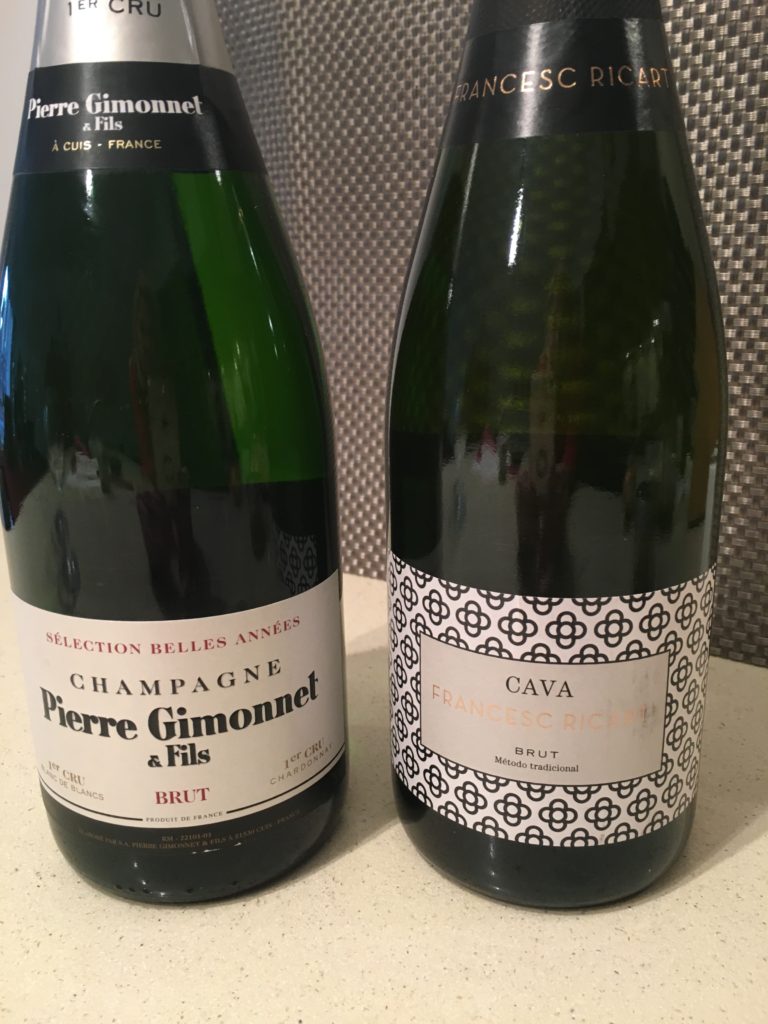Sparkling Saturday
As you all know from my previous Bubbles post, I like sparkling wine – champagne, prosecco, cava, European, American, if it is at all decent I’ll drink it but I’ve typically stuck to makers that I know. Sparkling Saturday was created to give me a reason to try out new makers and document what I thought.
Today’s choices are champagne – Pierre Gimmonet a grower champagne that I was coincidentally reading about in Karen MacNeil’s amazing book, The Wine Bible. As a side note if you don’t have this book you should. It’s a fantastic wealth of knowledge about wines and their various origins. I took a copy of the first edition with us when we traveled Europe for a month after we left London. As Ms.MacNeil notes in her book, a grower champagne is one produced by a smaller grower than the familiar big houses such as Bollinger or Roederer. The particular bottle that I chose for today is their blanc de blanc. Champagne typically is made of two or three grapes, most common are chardonnay, a white grape and pinot noir, a black grape, but some makers also include pinot meunier, also a black grape. You might see a champagne called blanc de noirs which is a champagne made exclusively from the black grapes. Back to blanc de blancs, this is a champagne made exclusively from chardonnay.
I also chose a cava since it is made in the same traditional method as champagne but uses different grapes. The typical grapes used in cava are macabeo, xarel-lo and parellada. Today’s cava is made by Francesc Ricart. It comes from the region of Penedes and Sant Sadurní d´Anoia.

The bottles side by side.

When I tasted them side by side there was more fruitiness to the cava, with lemon zest, some honey and on the nose a light floral honeysuckle aroma. The champagne had less of a fruit forward nature, and to me seemed more austere as I would expect from a champagne, but I also got a butterscotch undertone. This really surprised me so I went out and found some tasting notes and apparently others have noted that element. I’ve noticed that as I have let it sit as I write this that the butterscotch tones have lessened.
The champagne is delicious and I picked it up for $49.99 at my local wine shop. The cava was $17.99. I think in this case, for me it would come down to what I wanted to spend. The cava is delightful, fruity, with nice acidity and well balanced and at that price it can’t be beat. The champagne has just that little bit more which I would expect at the higher price point.

And finally the glasses. Which glass is the best glass? The glass on the right is a definite no no when it comes to sparkling wines since due to the shape the bubbles dissipate rapidly. So many of the mid-range bars in Manhattan use that glass for their sparkling wine and I think it must be because they can also use it for cocktails but it drives me crazy when I order a prosecco and they bring it in the couple. For the record, I also don’t like my martinis in a coupe, but that’s a story for another day. The flute on the left is elegant and fun to drink from and is okay since it captures the aroma somewhat, but really what has been shown recently is that the middle glass is the best shape for sparkling wines. I use this glass when I’m doing tastings but when I have a sparkling wine for a special occasion I usually end up with the flute, either this style or the more conventional style that slopes in at the top.
Which glass do you prefer for your sparkling wines?